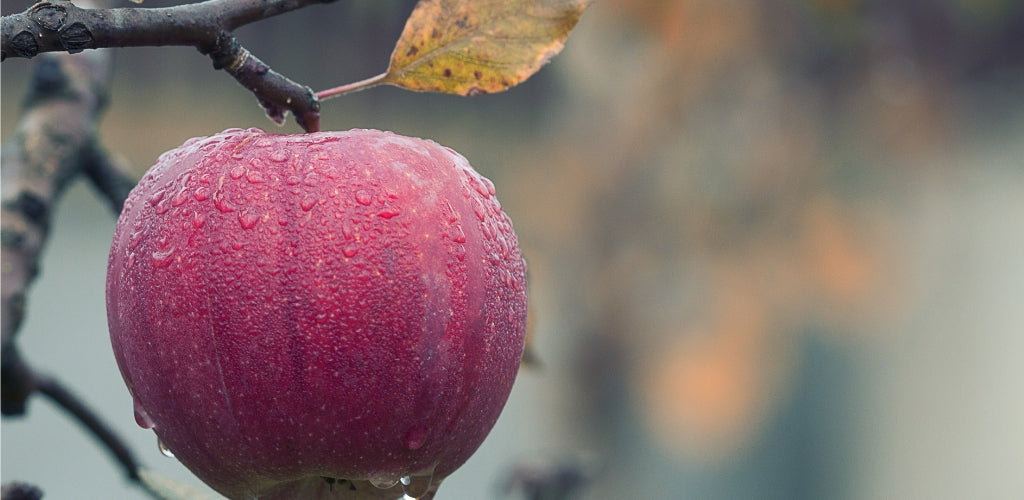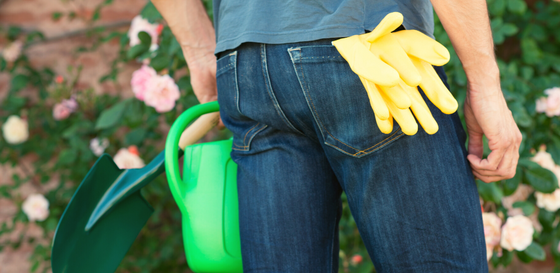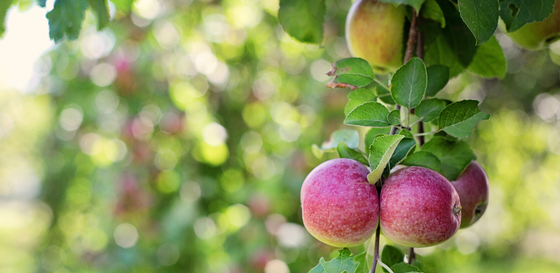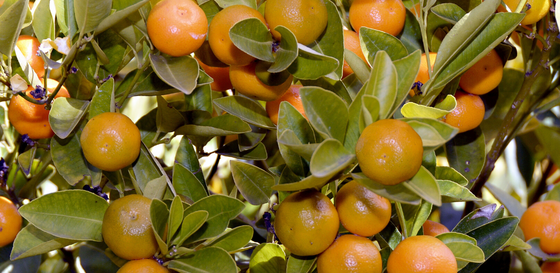
Autumn is here which means that your trees will start to shed their leaves. Don't stress, this is a normal process which happens every year. Here's a detailed guide showing you how to care for your trees in these Autumn months for bountiful trees.
It's also a great time to check if your tree needs balancing and pruning, and also to check for any rootstock growth that can be removed.
Run a soil pH test: Apples should be between 5.8 and 7.0, Citrus between 5.5 and 6.5 and stone 6.0 and 7.0.
If your tree is flowering out of season during these three months, don't be alarmed, it will probably shed the flowers again as it prepares to go dormant. Early flowering is usually caused by local temperature variations and/or unusual climate conditions
Don't be alarmed if your Stone or Apple Fruit Salad Tree leaves are looking rusty or have red spots, discolouring and even some holes in them because these trees are deciduous and their leaves begin to fall off. That's what they do at this time of year, they are going dormant for their annual sleep.
If your Apple or Stone Fruit Salad Tree leaves are not falling off by the end of Autumn, don't be alarmed, it just may not have been cold enough or there may not have been enough wind. Give the leaves a helping hand by running your hand along the branches and they should easily fall off.

Now is a great time to give some fertiliser to your Citrus Fruit Salad Tree as it prepares for it's Autumn flush, which is a fast growth period.
Imagine each graft is a tree growing off the side of the main central stem. Feed the stem (rootstock) and it will feed its grafts.
Stone Fruit Salad Trees and Apple Fruit Salad Trees start to think about shutting down soon for Winter, although in some climates they can continue to grow until March/April. If yours is still growing, don't apply just yet, but make sure to apply it by late May.
Make sure to vary your tree's diet. Slow release fertiliser is great (Osmocote with added trace elements), animal manure (cow, sheep, horse chicken). Note that Chicken manure is stronger so place on top of the mulch rather than underneath. Also add kitchen scraps from time to time. Place them under the mulch to attract earthworms.
When using fertilisers, keep away from direct contact with the trunk of the tree. If you live in a frost prone area, don't fertilise in late Autumn because this can encourage new growth that can be burnt off with frost. Wait for Spring instead.
The best mulch is a mixture of old grass clippings (not fresh), dried leaves and straw. The thicker the better as it breaks down over time. Top up every 6 months at least, to keep the moisture level consistent underneath.
Establish a well 'balanced' tree by cutting back the more vigorous growing grafts anytime during the growing season, approximately once a month. This is especially important while the tree is young and developing. Thin out the branching of each graft as needed, to equalise growth vigour otherwise the more vigorous growers will become bigger/stronger and dominate at the expense of the slower growers.
Do not just look at how long branches are and compare, also look at how many branches each graft has. If one graft has 6 branches and the others less, then cut some of the branching of the bigger one because more energy is being stored in the bigger graft. The thickness of the branch coming from the main central stem of the tree is an indicator of how much energy it's consuming.Hint: Keep each graft confined to grow in its own area of the tree; this will assist in recognising the faster and slower growers.
All new shoots emerging from the main central stem of the tree or from ground level, must be removed. This is the growth of the rootstock tree. The only purpose of the rootstock is to nourish the grafts attached to it.
Hint: Identify the different grafts growing from the main central stem e.g. put a dub of paint on them. These are the anchor points of each graft. Check and remove all other growth from the main central stem (rootstock).
Note: Citrus rootstock has long thorns and a small 3 pronged leaf so is easier to identify.
The ideal shape of a tree is a red wine glass, curving out from the centre and upwards. All growth needs to be encouraged in a direction away from the centre of the tree. Sunlight needs to be filtering to all branches and fruits, so keep the centre of the tree reasonably open, some light branch work in centre is ok. Prune out many inward growing branches and those growing in the wrong direction. This will not harm the tree but redirects energy to the outward growing branches.
Tip: Always cut above an outward pointing bud or leaf and thin out the laterals (branches) to make a strong framework.

During mid to late Autumn and Winter, Stone Fruit Salad Trees need to be sprayed to combat diseases which will harm your tree.
Make sure you spray Lime Sulphur by the end of May or by mid June in any Australian climate, before budswell, which means before the blossoms start to come out. Do it twice, waiting a week in between. Spray to the point of run off for thorough coverage. See the inside back cover of your Care Instructions for further details.
This spray application is to combat the disease called Leaf Curl, which if not treated, is apparent when the tree wakes up from dormancy. Lime Sulphur is not a dangerous chemical (bit smelly!) and you can purchase it anywhere where garden products are sold.
If your Stone Fruit Salad Tree leaves are already curling, use a copper spray with a few drops of dishwashing liquid before budswell (when the buds are beginning to get plumper). Don't apply after the buds have burst or it will burn the leaves.
It can be harder to get a good coverage of the spray onto the wood of the branches if leaves are still on the tree. So, apply the spray after the leaves have fallen. If leaves have not fallen off, take them off yourself.
If you miss spraying with the Lime Sulphur at leaf fall and you find that the buds on your tree begin to swell, getting a little bit "fluffy", it means it's getting ready to burst out with flowers (and fruits) and wake from dormancy. It is now time to spray with Copper Oxychloride. Spraying with Copper Oxychloride has critical timing because if flowers burst out on the tree before you spray with the copper, then it's too late for the protection. Be sure to spray it the next year.

If you entirely miss the two applications above, you may find the leaves that come out after the flowers (which come first), will be "buckled" or "twisted" or have what looks like "blisters" on the leaves. This condition is the Leaf Curl and you can simply remove those leaves (they look awful) and new growth will come. The new growth will have normal leaves. Each season you don't apply either of the clean up sprays, it will weaken the tree and one year, it just won't wake up out of dormancy.

We ship our Fruit Salad Trees to you when they are 55cm - 80cm. Trees are grown so that the fruiting branches begin from approximately 10cms above soil level, keeping the height to a minimum, which allows easy harvesting, eliminating the need for ladders.
The Stone Fruit tree grown in the ground will grow approximately 3 metres (10ft) high x 2 metres (6ft) wide. In the best conditions (e.g. warm coastal climate, plenty of fertilizer, water etc.) these trees grow approximately 1 metre per year or more. Stone Fruit Salad Trees take approximately 3 years to reach maturity, when grown in the ground optimal conditions.
The Citrus grafts are grown on dwarf rootstock which means the tree grown in the ground will only grow approximately 2 metres (6ft) high x 2 metres (6ft) wide. In the best conditions (e.g. warm coastal climate, plenty of fertiliser, water etc.), these trees grow approximately a bit less than half a metre per year, less if in a cold climate.
Citrus Fruit Salad Trees take approximately 5 years to reach maturity, when grown in the ground in optimal conditions.
Apple Fruit Salad Trees grown in the ground will grow to approximately 2-3 metres (6-9ft) high x 2 metres (6ft) wide. In the best conditions (e.g. warm coastal climate, plenty of fertiliser, water etc.), these trees grow approximately a bit less than 1 metre per year, less if in a cold climate. We strongly recommend to espalier the "fan" shape by tying to support the branches.
If you want the trees to be shorter than the above measurements, you will have to regularly prune them to grow them in pots or, grow them sideways (espalier method).

You can espalier any of our trees. You just need to tie the branches into position when they are green in their bark and easily moveable. Keep each graft growing in its own area, so you can watch the growth habit of each and keep them growing evenly and balanced.
Apple Fruit Salad Trees are particularly suited to be grown by the espalier method, because their branches get laden with fruits and this way they can be well supported.
Citrus is ever-green so balancing and pruning your tree is important throughout the year. After fruiting, cut back just a little and thin out branching for sunlight penetration. Heavy pruning is not required.
Stone Fruits and Multi-Apples require balancing during their growing season.
Apart from the continual pruning for balancing and for shape, apply additional pruning during late May/early June. A guide for this is to prune 1/3 (young tree) to 1/2 (mature tree) of last season's growth. You can tell how much the tree grew last season by the different colours of the bark. Cut just above an outward pointing bud, not a bud on the inside of the branch because you don't need growth going in towards the middle of the tree. All growth needs to point away from the centre. Keep the middle fairly clear so sunlight can penetrate through the tree. Cut out any dead wood as well.
You can grow your Fruit Salad Tree in a pot, which is perfect for fruit lovers in urban areas. Read more about growing different fruit on the same tree in a pot here.
Here at Fruit Salad Trees, we stock a wide range of fruit trees, which all boast different fruit on the same tree. Each fruit variety retains its own flavour, appearance and ripening time. We graft citrus, stone fruit and multi-apple trees.
Shop our wide range of trees now and check out our current specials here!
Comments will be approved before showing up.

A handy list of essential items to make your gardening journey easier! From simple things like gardening gloves right through to fruit tree netting and a pH soil test kit, these will really help set you up for success in your patch. Whether you plan to grow veggies, fruit trees or flowers, this list will give you the confidence to get out in the garden and make the most of it all!

Here are some tips to help you keep your Fruit Salad Tree at it's best throughout the year. We all get busy and sometimes the garden jobs get forgotten. We get it!
We've popped these tips and tricks into categories (eg Citrus or Apple or Stonefruit) and then into seasons (eg in autumn remember to do this or keep an eye out for this in summer, etc.) to make things as easy as possible.
Happy, healthy fruit trees grow more fruit and that will make everyone happy!

There are many ways that you can become more sustainable and growing your own beautiful fruit tree at home is a great way to start!
In this short video, Kerry shows her veggie garden and the different types of Fruit Salad Trees to compliment edible gardens big and small.